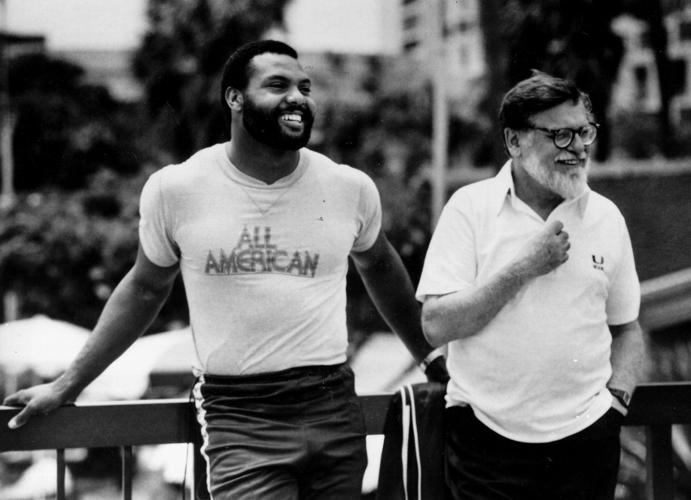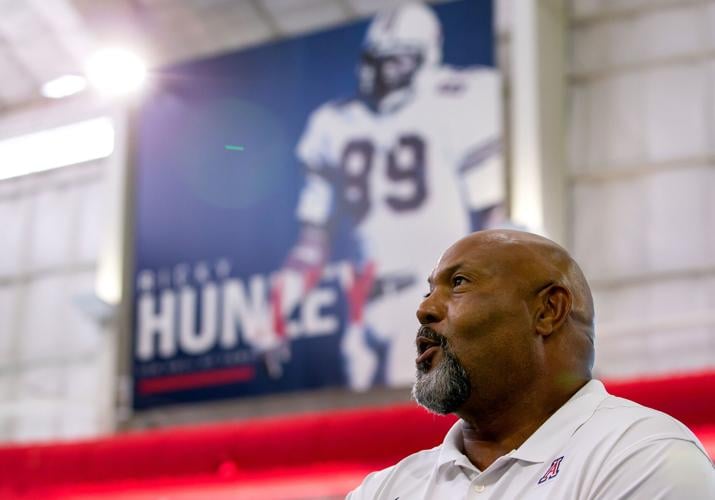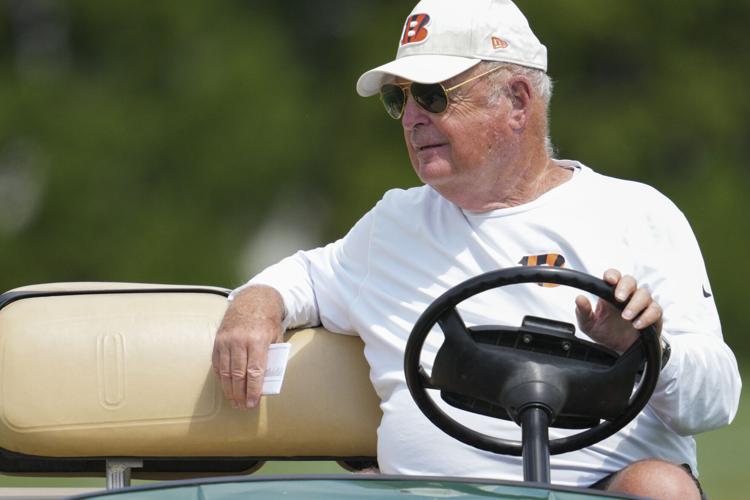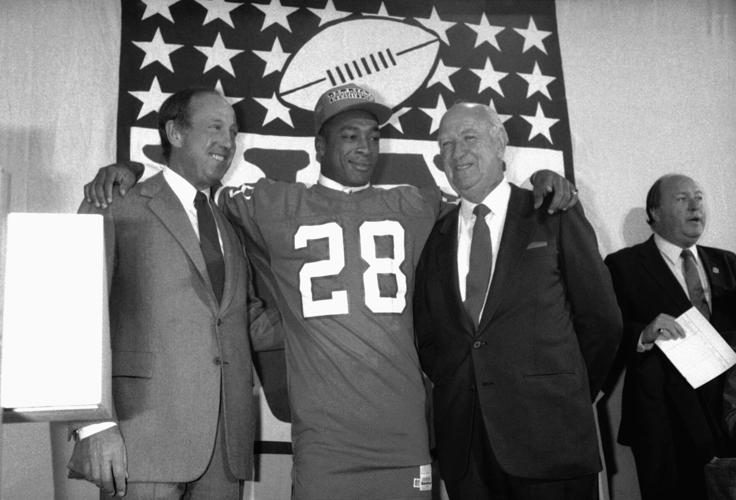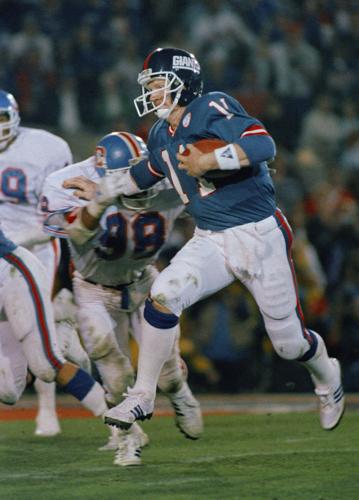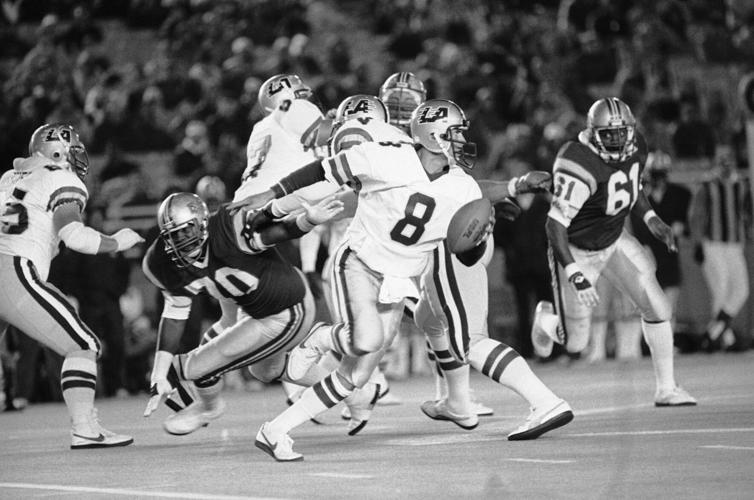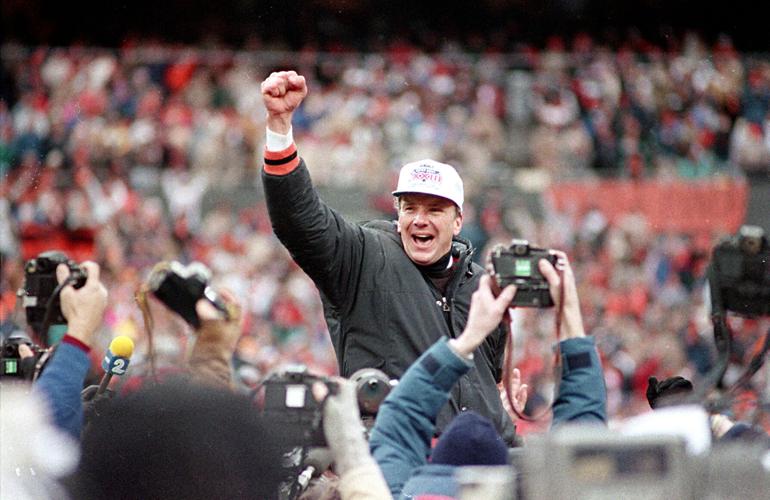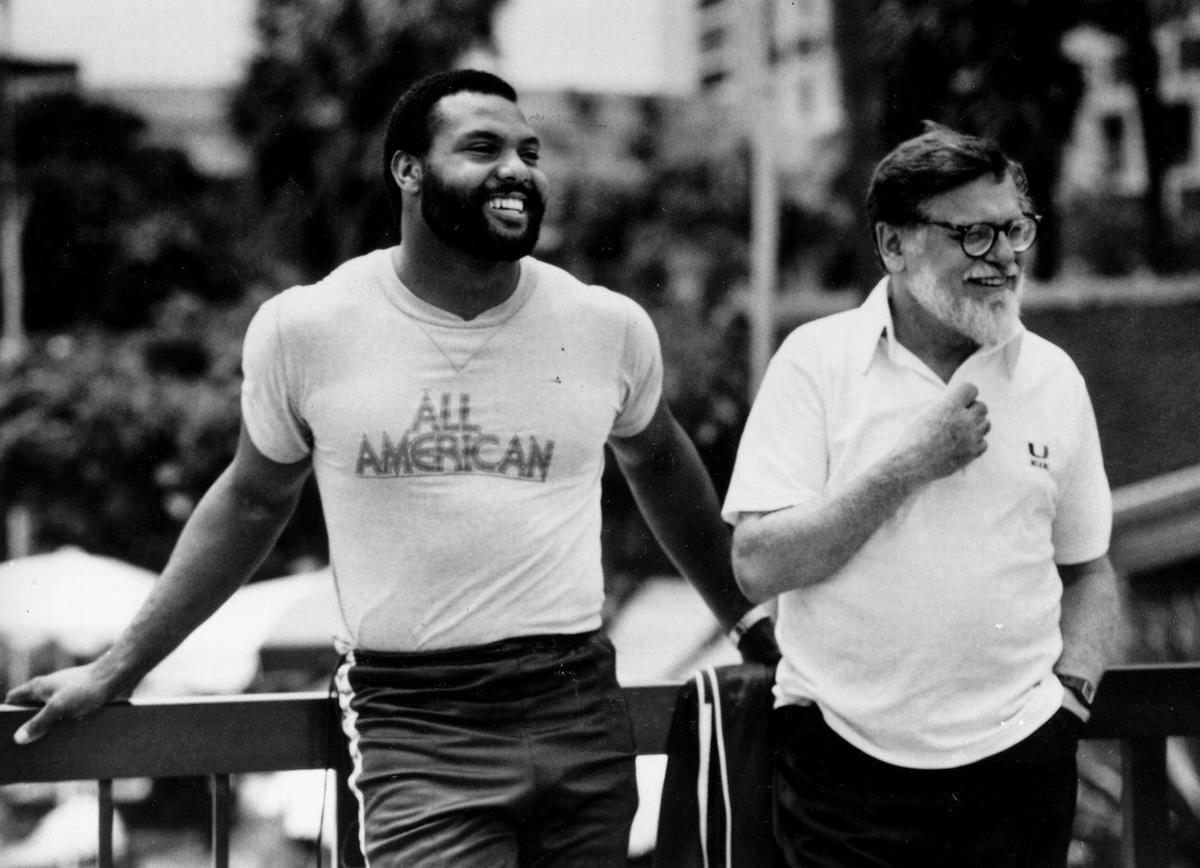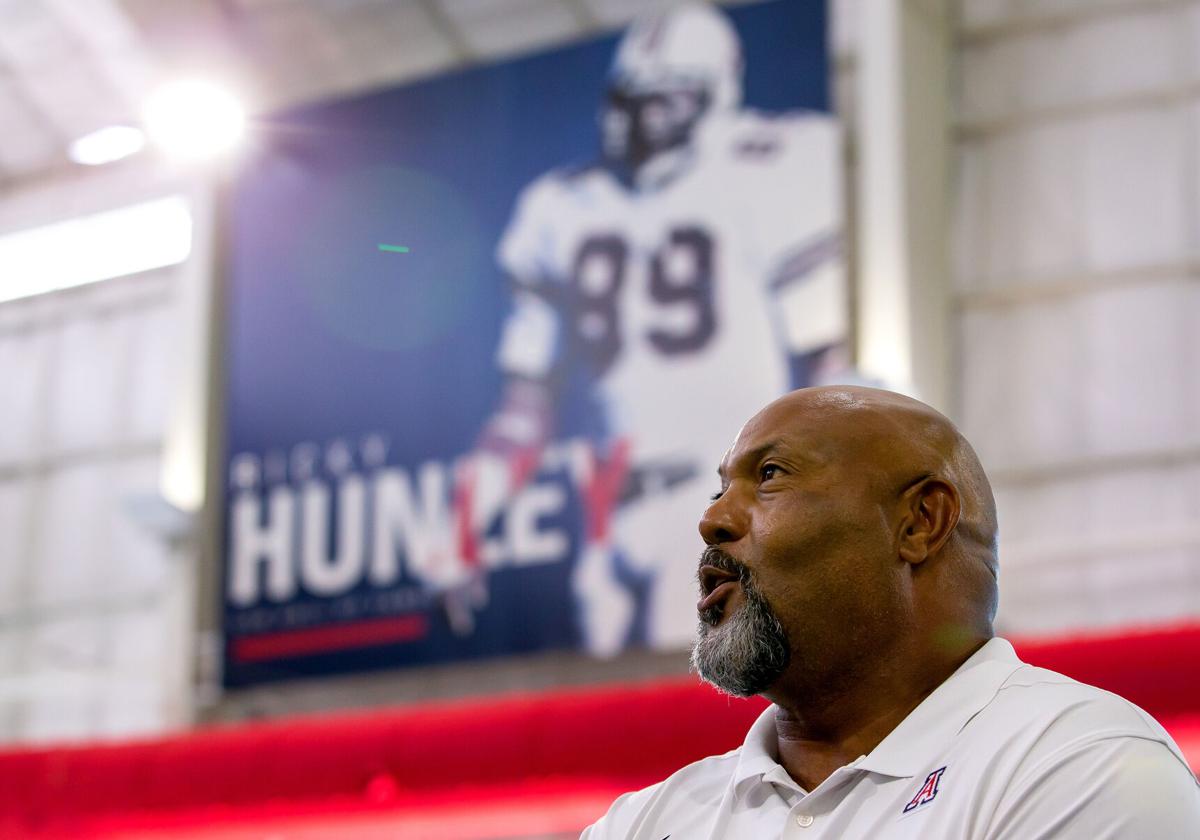Forty years ago, Ricky Hunley was hanging out in his apartment on Fort Lowell Road when he became the highest NFL Draft pick in the history of Arizona football.
Hunley and his roommates/teammates — brother Lamonte Hunley and Randy Robbins — didn’t have cable, so they couldn’t watch the draft on ESPN. A neighbor told Ricky that he’d been taken by Cincinnati with the No. 7 overall pick. Bengals coach Sam Wyche called soon afterward.

Michael Lev is a senior writer/columnist for the Arizona Daily Star, Tucson.com and The Wildcaster.
What was Hunley wearing on that life-changing day?
“A T-shirt and shorts,” he said. “I didn’t even have on shoes sitting there on the phone with Sam.”
And what did he do after they hung up?
“I went to class,” Hunley said.
Over the past 40 years, the NFL Draft has become an American institution. It is a rite of spring — the most riveting reality show on TV.
Yet just about everything about the 1984 NFL Draft feels unfamiliar. The way it was consumed, how it all went down, what transpired afterward — it might as well have been 1884.
And Ricky Hunley, Arizona’s All-American middle linebacker, played a central role in the drama.
Hunley the holdout
Did you know that the highest-drafted Wildcat ever never played for the team that selected him?
Hunley was a holdout, a once-common term in the NFL lexicon that’s gone the way of the fullback since 2011, when a new CBA introduced a set rookie wage scale. Today, it’d take uncommon conviction to even attempt what Hunley and his agent, Howard Slusher, instigated: a protracted holdout that eventually led to a trade.
“The money is big,” Hunley said during a recent interview in his office at the Lowell-Stevens Football Facility, where he serves as the Wildcats’ executive director, player relations and external development. “And nobody wants to turn down that kind of money.”
The seventh pick in this year’s draft, which begins Thursday in Detroit, will receive a four-year contract worth approximately $25 million, with a $15 million signing bonus. According to a UPI story from Sept. 6, 1984, Hunley rejected a final offer of four years for $1.6 million — half of what he and Slusher were seeking.

Ricky Hunley, left, departed Arizona as the Wildcats' all-time leading tackler. He became the highest-drafted UA player ever — but never played for Cincinnati, the team that selected him.
The Bengals’ offer was less, on a per-year basis, than the three-year, $1.475 million deal another ’84 Cincinnati draftee had signed. Except quarterback Boomer Esiason was a second-round pick, No. 38 overall.
At that time, the Bengals had a reputation for — how can I say this nicely? — thriftiness.
“They were cheapskates,” Hunley said. “Low-ballers.”
The Bengals’ reputation preceded them. Hunley had heard as much from multiple player agents. When he hired Slusher — who once referred to himself as the “holdout king” — it almost ensured that the negotiations would be contentious.
A different game
Hunley didn’t want the Bengals to take him. But they wanted him. They had most of the draft plotted out, as then-Cincinnati Enquirer reporter Peter King learned when he visited with Wyche in his office the day before the selection process began on May 1, 1984.

Sam Wyche eventually led the Cincinnati Bengals to the Super Bowl, but they did it without their top pick in the 1984 draft, Arizona's Ricky Hunley, who never signed with Cincinnati and was traded to Denver.
“He said these words to me, which I'll never forget. ‘Do you want to know who we're gonna pick?’ I thought he was kidding,” King, the recently retired NFL chronicler of later Sports Illustrated and NBC fame, said in a phone interview this week.
Wyche told King about Hunley, defensive tackle Pete Koch (the Bengals’ selection at No. 16), Esiason and running back Stanford Jennings (their third-rounder), among others. As long as he didn’t tell anyone outside Cincinnati, King had the go-ahead to write a story about the prospective picks in the next day’s newspaper. Can you imagine?
Remember: This was five years before the birth of the World Wide Web and email. King would have had to call someone to disseminate that information. Or send a fax.
“That's how confident Sam was that he could tell me whatever he wanted to tell me,” King said.
More from the This Would Never Happen Today Department: The Bengals went into the offseason with the No. 1 overall selection but traded down for picks 16 and 28 (among other compensation). Why would they do such a thing? Because the top college quarterback, BYU’s Steve Young, had signed with a rival professional football league, the USFL.

BYU quarterback Steve Young was supposed to be the No. 1 pick in the 1984 NFL Draft, but he signed with the L.A. Express of the rival USFL.
New England was Cincinnati’s trade partner, and the Patriots used that No. 1 pick on Irving Fryar, a wide receiver from Nebraska. It was only the second time in history that a receiver had gone first overall. It’s only happened once since (Keyshawn Johnson, 1996).
The Bengals set their sights on Hunley, who had accumulated a school-record 566 tackles at Arizona. Would a team use a top-10 pick on an old-school middle linebacker nowadays? Probably not.
The last “off-ball” linebacker to go in the top 10 was Isaiah Simmons in 2020, and Simmons was more of a safety at Clemson. Only four off-ball ’backers have been taken in the top 10 in the past 11 drafts. (It won’t happen this year either.)
The sport was different in the mid-’80s. Battering ram Earl Campbell (232 pounds) was coming off a 1,301-yard rushing campaign for the Houston Oilers, one of the Bengals’ rivals in the AFC Central. Pittsburgh still had Franco Harris (230 pounds). Cleveland had Mike Pruitt (222). Cincinnati’s leading rusher was Pete Johnson (252).

Nebraska receiver Irving Fryar is flanked by NFL commissioner Pete Rozelle, left, and Patriots owner William Sullivan after New England selected him with the first pick in the 1984 draft in New York.
Wyche and the Bengals saw an antidote in Hunley. But the marriage never materialized as Hunley used what little leverage he had to try to get what he wanted. It was either the USFL — where the Arizona Wranglers had made Hunley one of their “territorial” picks — or holding out.
There was no such thing as “player empowerment” in those days. In fact, in a feature about the ’84 draft, NFL Films did a whole “Big Brother” theme, playing off George Orwell’s novel “1984.” Big Brother was still in charge, albeit under threat from little brother (the USFL).
Standoff, breakthrough
Although holdouts were far more frequent back then, the public still tended to side with ownership.
“People in the community were like, ‘Who do you think you are? Why are you holding out? They're offering a million dollars and you're here,’ ” Hunley said. “I'm arguing with people in the grocery store about what I should be doing with my life.”

Bengals owner Mike Brown was the team's lead negotiator when Cincinnati drafted and tried to finalize a contract with Arizona linebacker Ricky Hunley. The two sides never came to an agreement.
King flew to Tucson to write a story from Hunley’s perspective. Bengals executive Mike Brown, who later became the team’s principal owner, was none too pleased. He approached King at an offseason camp.
“Mike Brown, with fire in his eyes, came up to me on the sidelines and said, ‘Let me tell you something, counselor,’ ” King recalled. “He started defending his position, his offer. It was just really a contentious conversation. And he kind of stormed away. The standoff continued.
“I’ll give this to Ricky: Man, he held his ground. He believed in something very firmly.”
Hunley had to fight off FOMO. He’d been playing football since he was 6 years old.
“I knew I was missing something,” Hunley said. “Because I'd never missed before.”
Finally, just before the October trade deadline, Cincinnati swung a deal with Denver. The Bengals received three future picks. The Broncos — who had selected Arizona’s Robbins and Chris Brewer in the fourth and ninth rounds of that same ’84 draft — got the rights to Hunley.
The aftermath

Ricky Hunley was traded from Cincinnati to Denver and played in two Super Bowls for the Broncos, including SB XXI on Jan. 25, 1987, at the Rose Bowl, where he's shown chasing New York Giants quarterback Phil Simms.
The whole affair could be viewed as a win-win. Cincinnati used two of those future picks on receiver Tim McGee and safety David Fulcher, who helped the Bengals reach the Super Bowl after the 1988 season. The Broncos played in the previous two Super Bowls, with Hunley starting at inside linebacker.
King and Hunley agreed with that idea — to an extent. King theorized that the Bengals regretted never having made it work with Hunley because they envisioned him as a “defining player” for their defense. Although he believed in what he was doing, Hunley conceded that he lost something in the process.
“You get traded somewhere, it's not like … when you get drafted somewhere,” Hunley said. “I don’t get invitations to come to Cincinnati for any reunions or anything, you know?”
Hunley played seven seasons in the NFL before becoming a coach — including a stint with the Mike Brown-owned Bengals.
Arizona has had six first-round picks since 1984, but none have gone higher than Hunley.

Ricky Hunley, right, never played for Cincinnati, but he did end up coaching with the Bengals almost 20 years after the team picked him in the first round of the 1984 NFL Draft.
“It's a pretty high honor,” he said. “I’m sure it'll be broken someday.”
That day could be just a year away.
If he stays healthy and has the season he’s expected to have, receiver Tetairoa McMillan could supplant Hunley as the Wildcats’ highest draft pick. Hunley would gladly pass the baton.
Regardless of where he gets picked, it’s safe to assume T-Mac won’t be oblivious to the draft. He won’t be sitting in an apartment without cable or cameras.
He might even wear shoes.
The Star's Justin Spears and Michael Lev preview the NFL Draft and evaluate how Jordan Morgan, Jacob Cowing, Michael Wiley and Tanner McLachlan stand on draft week. Will Morgan crack the first round? Will anyone else from the UA sneak into the draft? Plus, a look at other Pac-12 prospects and quarterbacks.


